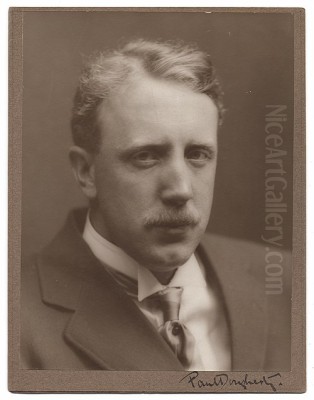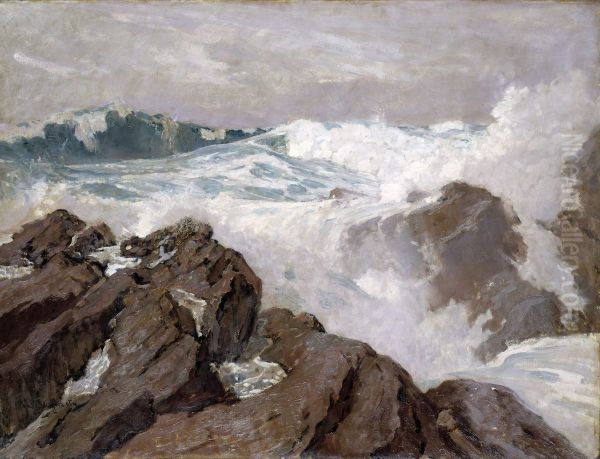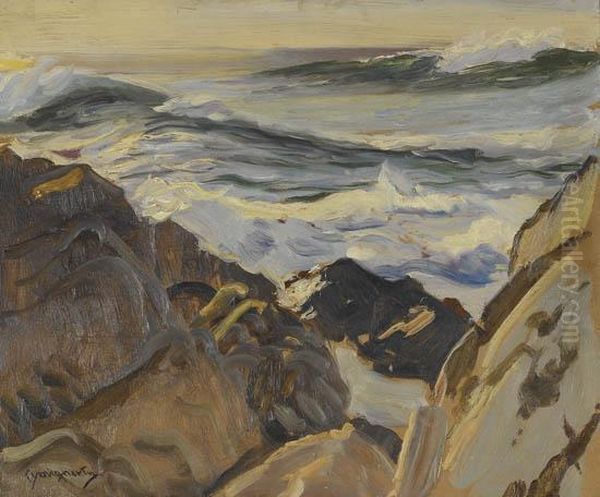
Paul Dougherty stands as a significant figure in early 20th-century American art, celebrated primarily for his powerful and evocative depictions of the sea. Born into an era of artistic transition, Dougherty carved a unique path, abandoning a promising legal career to capture the dynamic relationship between water, rock, and light. His canvases, often characterized by vigorous brushwork and a profound understanding of marine forces, earned him widespread acclaim and a lasting place in the annals of American landscape painting.
Early Life and a Change of Course
Paul Dougherty was born in Brooklyn, New York, on September 6, 1877. His father was a prominent lawyer, and the expectation was that Paul would follow a similar professional trajectory. He pursued this path diligently at first, attending the Polytechnic Institute of Brooklyn where he earned a Bachelor of Science degree. Subsequently, he enrolled at the New York Law School, graduating with a Bachelor of Laws (LL.B.) degree in 1898. He was admitted to the bar and briefly engaged with the legal profession.
However, the pull towards art proved irresistible. Even during his formal education, Dougherty nurtured his artistic inclinations. He had received some early guidance from painter Constantin Hertzberg. His talent was evident early on; remarkably, he exhibited a painting at the prestigious National Academy of Design (NAD) when he was just eighteen years old. This early success likely fueled his passion and solidified his decision to pivot away from law and dedicate his life entirely to painting.
European Sojourn and Artistic Formation
Recognizing the need for deeper immersion and training, Dougherty embarked on an extended study trip to Europe in 1900, remaining abroad for five crucial years. This period was instrumental in shaping his artistic vision and technical skills. He traveled extensively, absorbing the art and culture of major centers like Paris, London, Florence, Venice, and Munich. This wasn't about enrolling in a single academy but rather about broad exposure and selective study.

During his time in Europe, he actively sought out instruction and inspiration. He spent time studying with the influential American painter and teacher Robert Henri, known for his advocacy of realism and capturing modern life, who would become a leading figure in the Ashcan School. This connection likely reinforced Dougherty's interest in direct observation and vigorous technique. His European travels also exposed him to the masterpieces of the Old Masters, and sources suggest a particular interest in the dramatic light and shadow of artists like Rembrandt, whose techniques he studied closely.
Furthermore, this period placed him in the vibrant European art scene during a time of significant innovation. He had opportunities to see the works of, and potentially interact with, leading modern artists. While direct collaboration isn't heavily documented, his time in Paris coincided with the flourishing of Post-Impressionism and the rise of Fauvism, exposing him to the radical color experiments of figures like Henri Matisse and the structural concerns of Paul Cézanne. This exposure broadened his artistic horizons beyond academic tradition.
The Emergence of a Premier Marine Painter
Upon returning to the United States around 1905, Dougherty quickly established himself as a formidable talent, particularly in the realm of marine painting. He was elected an Associate of the National Academy of Design in 1906 and achieved full Academician status just a year later, in 1907 – a swift recognition of his abilities. His chosen subject became the dramatic meeting of land and sea, focusing initially on the rugged coastlines of Maine and Cornwall, England.
Dougherty developed a distinct approach to marine painting that set him apart. He was less interested in anecdotal detail or maritime activities and more focused on the elemental forces at play: the weight and movement of water, the solidity of rock formations, and the transient effects of light and atmosphere. He possessed an almost scientific fascination with wave mechanics, studying how swells formed, crested, and broke against the shore.
His paintings from this period often depict scenes of considerable energy – waves crashing against unyielding cliffs, spray erupting into the air, storm clouds gathering overhead. Yet, he was equally adept at capturing moments of relative calm, the rhythmic surge of the tide under a silvery moon, or the play of sunlight on quieter waters. His work resonated with critics and the public alike, who admired his technical skill and the emotional power of his seascapes.
Signature Style and Technique

Paul Dougherty's style is characterized by its directness, energy, and structural integrity. He typically employed vigorous, often thick brushwork (impasto), which conveyed the texture of rock and the dynamic movement of water. His compositions are generally strong and well-structured, often featuring diagonal lines created by receding waves or jutting rock formations, adding to the sense of depth and dynamism.
His color palette, while capable of capturing brilliant sunlight, often favored cool blues, greens, and grays for the water and sky, contrasted with the earthy tones of the rocks – ochres, browns, and deep umbers. He masterfully handled light, whether it was the diffused light of an overcast day, the dramatic chiaroscuro of a storm, or the sparkling brilliance of sunlight on wave crests and sea foam. His understanding of light was crucial in defining form and creating mood.
Compared to his great predecessor in American marine painting, Winslow Homer, Dougherty's work is perhaps less focused on narrative or the human element within the landscape and more concentrated on the raw power and abstract beauty of the natural forms themselves. While Homer often included figures battling the elements, Dougherty's coasts are frequently unpeopled, emphasizing the timeless drama of nature. His approach differed also from contemporaries like Frederick Judd Waugh, whose seascapes could sometimes lean towards the theatrical; Dougherty maintained a sense of grounded realism even in his most dramatic depictions.
Major Works and Widespread Recognition
Throughout his career, Paul Dougherty produced a significant body of work, with several paintings becoming iconic representations of his style. Storm Voices (circa 1912) is frequently cited as a quintessential Dougherty seascape, capturing the sound and fury of waves crashing against a rocky shore with palpable energy. Land and Sea is another well-known title, likely representing his core thematic interest. Other notable works include Sun and Storm, Heavy Sea, October Seas, Rock and Spray, and Coast of Maine, all suggesting his focus on different moods and conditions of the ocean environment.
His talent did not go unnoticed. Dougherty received numerous prestigious awards throughout his career, cementing his reputation. He won a silver medal at the Carnegie International exhibition in Pittsburgh in 1914, a highly respected international showcase. He was awarded a gold medal at the Panama-Pacific International Exposition in San Francisco in 1915. Further accolades included the Carnegie Prize in 1923 and a prize from the National Arts Club in 1941.

His paintings were eagerly acquired by major museums across the United States. His work entered the collections of institutions such as the Metropolitan Museum of Art in New York, the Smithsonian American Art Museum and the National Gallery of Art in Washington, D.C., the Art Institute of Chicago, the Cleveland Museum of Art, and numerous others. This institutional recognition underscored his importance in the landscape of American art.
Context: Contemporaries and Influences
Paul Dougherty's career unfolded during a dynamic period in American art. His connection with Robert Henri places him in the orbit of the Ashcan School, artists dedicated to depicting urban realism, though Dougherty applied a similar vigorous realism primarily to nature rather than city life. Figures associated with Henri, like John Sloan and George Bellows, shared an interest in bold brushwork and capturing the energy of their subjects, albeit different ones.
As a marine painter, Dougherty inevitably invites comparison with Winslow Homer, the dominant figure in the previous generation. While both depicted the Maine coast, Dougherty's focus was more purely on the elemental forces. He also worked alongside other successful marine specialists like Frederick Judd Waugh and Charles Herbert Woodbury. Woodbury, also an influential teacher, shared Dougherty's analytical interest in wave motion. Dougherty's dramatic coastal scenes also find echoes in the work of Rockwell Kent, another artist drawn to rugged, powerful landscapes.
While primarily a realist, Dougherty's handling of light and atmosphere sometimes shows an awareness of American Impressionism, practiced by artists like Childe Hassam and Willard Metcalf, who also painted coastal and landscape scenes, though often with a lighter palette and focus on fleeting light effects. The comparison sometimes made to James McNeill Whistler, noted in the source material, likely refers to a shared sensitivity to tonal harmonies and atmospheric effects, particularly in Dougherty's more subdued or moonlit scenes, rather than a direct stylistic borrowing. His work stands apart from the more mystical seascapes of an artist like Albert Pinkham Ryder but shares a profound engagement with the power of nature.
The California Years
Around 1928, seeking a change of scenery and perhaps climate, Paul Dougherty moved west and settled in the burgeoning art colony of Carmel-by-the-Sea, California. This marked a new chapter in his life and work. While he continued to paint the sea, his subject matter expanded to include the distinctive landscapes of his adopted state.
The dramatic coastline of the Monterey Peninsula and Big Sur offered new motifs, different in character from the shores of Maine or Cornwall. He captured the unique light of California, the rugged cliffs plunging into the Pacific, and the characteristic cypress trees clinging to the headlands. Works like California Coast reflect this later phase.
Beyond the coast, Dougherty also turned his attention inland, painting the rolling hills and potentially the desert landscapes of the Southwest. While perhaps less famous than his marine paintings, these later landscapes demonstrate his continued engagement with direct observation and his ability to adapt his technique to different terrains and atmospheric conditions. He remained an active figure in the California art scene during this period.
Later Life and Enduring Legacy
Paul Dougherty continued to paint into his later years, though health issues eventually arose. He passed away in Palm Springs, California, in 1947, leaving behind a substantial and highly regarded body of work. At the time of his death, he was widely considered one of America's foremost marine painters.
His legacy rests on his powerful, honest depictions of the sea. He brought a unique combination of technical skill, keen observation, and emotional depth to his subject. He avoided overt sentimentality, instead conveying the ocean's grandeur and force through a mastery of form, color, and composition. His work captured the essential conflict and harmony between the enduring rocks and the relentless, ever-changing water.
While artistic tastes shifted in the decades following his death with the rise of Abstract Expressionism and subsequent movements, Dougherty's work has retained its appeal and importance. His paintings are valued not only as beautiful objects but also as masterful representations of the American landscape tradition. He stands as a key figure bridging the realism of the 19th century and the burgeoning modernism of the 20th, admired for his technical prowess and his profound connection to the natural world, particularly the untamed beauty of the sea.
Conclusion
Paul Dougherty's journey from law student to celebrated artist is a testament to his dedication and singular vision. His life's work was the sea, in all its moods – from tranquil calm to tempestuous fury. Through his canvases, he communicated a deep respect for the power of nature, rendered with a vigorous technique and a sophisticated understanding of light and form. His paintings continue to resonate with viewers today, offering compelling glimpses into the timeless drama of the ocean and securing his position as a master of American marine painting alongside luminaries like Homer and Waugh, and a respected contemporary of realists like Henri and Bellows, and landscape painters like Metcalf and Kent. His art remains a powerful testament to the enduring allure of the coast.